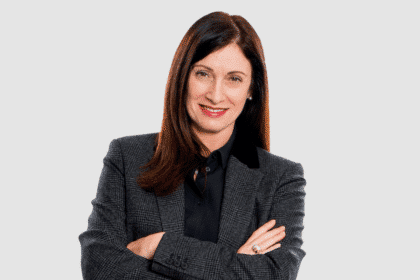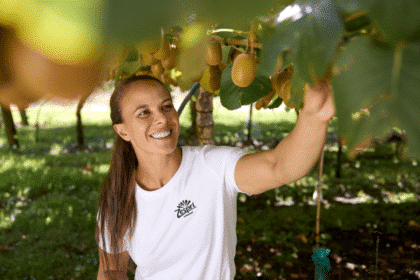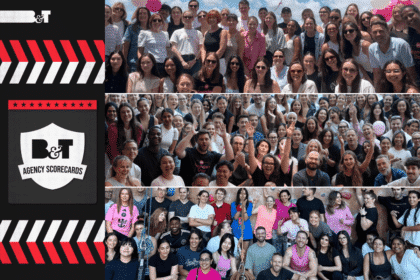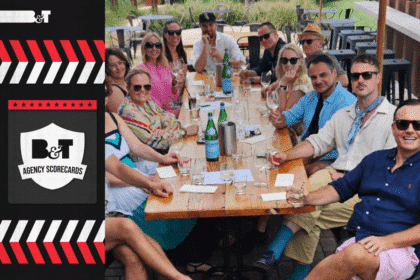Kellie Holt (lead image) is Atomic 212°’s head of content and creative media and is freshly returned from Cannes. Here’s her take on the week-long event in the South of France and why she’s found renewed optimism about advertising’s future…
In 1972, one single image helped stop a war. Today, thousands of them cannot.
As Russia’s war on Ukraine continues its brutal path, the rest of the world has already tuned out. That was the emotional message from Ukrainian singer and Eurovision winner Jamala during ‘Creativity Under Bombs’ – one of the first panel discussions to kick-off the Cannes Lions International Festival of Creativity 2022.
On February 24 this year, the music stopped in Ukraine and was replaced by the sounds of gunfire, bombs and tanks. Jamala stopped creating and turned to public speaking in desperation.
How can death become normalised across the world?
The notion of ‘creative fatigue’ is as true for brand ads as it is for war. Morally, it seems reprehensible, and yet the democratisation of media, along with the universal accessibility of distribution channels (largely through social media), has left us inundated and overwhelmed. Every day, millions of images and video footage flood our screens. There’s a lot of noise, and marketers are equally responsible for it.
Combined with the diminishing attention economy, it’s now quite literally killing people.
From the impact of wars and pandemics in this world, to building entirely new digital worlds with Web3, to the most divisive topic of all – Paris Hilton – so began five days of the industry’s takeover of Cannes to discuss, debate and debunk some of the industry, and the world’s, most pressing challenges and topics. All powered by rosé and the Côte d’Azur’s summer sun.
CREATING NEW WORLDS
Web3 and the metaverse was talked about everywhere – and it’s dividing us right down the middle.
There’s incredible excitement and energy, alongside a lot of confusion and cynicism. The evangelists are equating it to the dot.com boom of the 1990s, while the traditionalists say it’s just a fad that won’t last (which, ironically, is exactly what happened in the ‘90s).
While the definitions and direction may be as clear as mud, what is crystal clear is that digital, decentralised environments are fully immersive and participatory places fuelling immense creativity, creation, radical self-expression, discovery, and community.
It’s as far from scrolling through a social feed as you can get – and where people go, brands will always follow.
There is an incredible opportunity right now for early-adopter brands to authentically leverage Web3 and participate. However, making a digital version of your product for the metaverse just isn’t going to cut it. Brands need to show up in new ways to create, build and collaborate.
Loreal is partnering with the Sandbox metaverse and blockchain lab People of Crypto to create virtual product collections for different skin shades, gender identification, sexual orientation and make-up looks for avatars. They’re also collaborating with artists to create virtual looks for their customers to trial, and then apply and buy in the real world. It’s a smart way to test out radical looks or personal transformations without the real-world lasting implications of a beauty experiment gone wrong.
Lego’s chief product & marketing officer, Julia Goldin, spoke of how they are using the metaverse to create fun learning and education spaces for kids, and forming partnerships to help shape the future of the metaverse so that children and families are protected and can participate safe from the predatory behaviours which are destined to traverse both worlds.
Personally, I’m not in the metaverse yet but I want to be. I want to learn more. Perhaps unsurprisingly, the most fierce and outspoken critics were often those who knew the least about it let alone trialled or participated themselves. So here comes Kellie 3.0.
CELEBRITY CRUSHES
Regardless of how sophisticated the Cannes crowd may be, pop-culture celebrities still crush.
Over five days we heard from the likes of Paris Hilton, Ryan Reynolds, Nikolaj Coster-Waldau and Sir Patrick Stewart to name but a few. And each session was packed out.
Hilton talked NFTs and the metaverse alongside the ad man everyone loves to hate, Gary Vaynerchuk (to quote another delegate, “liking him is the industry equivalent of liking Joffrey in Game of Thrones.” Ouch). On the eve of their session ‘The NFT Revolution and What It Means For Brands’, the CCO of a high-profile agency group denounced the session to me as “everything that is wrong with the advertising world”.
Paris Hilton’s self-made brand is ‘blonde’, and the traditional industry types have swallowed it up. But ‘blonde’ she is not. A savvy entrepreneur and early adopter – the original social influencer and now metaverse pioneer – Paris has been doing things long before the industry has caught up. Her media company, 11:11 Media, is now working with brands to integrate into the metaverse (where she also now DJs from the comfort of her real-world bed – in a post-covid/WFH world, I can completely relate).
Sidenote: post-session, said CCO conceded: “She’s impressive.”
Ryan Reynolds is the newest and most lovable recruit to the advertising world, having effortlessly segued from actor to marketing and production powerhouse with his agency Maximum Effort (last year acquired by MNTN, where he now holds rank as CCO).
Reynolds’ handsome face was plastered on the building directly across from the Palais, two stories high and two sides of a building wide – the guy knows how to get noticed – and his message is simple: when it comes to brand advertising, make it fun, make it relevant, embrace imperfection and make it fast.
HOW TO TALK HUMAN
There was a lot of talk around the humanisation of brands – adopting the same traits as people and showing up in a similar way. This may be right for some brands, but I really don’t need my toothpaste talking to me about politics – but make me laugh (and give me beautifully clean teeth) and I’ll be yours forever.
In saying that, the underlying principles of success are as true for people as they are for brands – know who you are and what you stand for (values), have great friends (i.e. teams, partnerships and collaborators), use your voice wisely (clear and consistent message), don’t be afraid to fail (live and learn), and own it if you do (be vulnerable and accountable).
Finally, strive to be the best at what you do
With all the incredible data and technology available to us, we’ve forgotten how to speak human. We need to step out of the fishbowl mentality of ‘marketers ‘and ‘consumers’. Brands and marketers that can harness the power of tools and technologies and marry them to our core human needs and wants will win out.
Mastercard, for example, are ditching the traditional consumer funnel (awareness, consideration, conversion) and opting for a multi-sensory marketing strategy to engage the five human senses and connect with the emotions they evoke to drive mental availability.
They’ve now got restaurants, perfumes (a pretty decent one) and CMO Raja Rajamannar gave us the preview of their first-ever album, supporting global emerging artists – each song subtly integrates the brand’s sounds. In some countries, the brand’s ‘Acceptance’ sound can even be heard at the check-out when you swipe your card.
Fun fact – 70 per cent of people in relationships cheat, even with the potential consequences. So forget brand loyalty as a metric, Raja says we’re just not hardwired for it.
GENERATIONAL DIVIDE (AND CONQUER)
In an industry historically known for its burnout and cynicism, we often lose perspective and purpose – we typically aren’t saving lives. But as the industry literally built on creative communication and behaviour change, we do have that power.
The Ukrainian advertising industry went from planning the latest brand campaigns to fleeing their homes and offices. In a single day, their world as they knew it stopped.
So their talents became their weapons.
Creative director Oleg Tomic (Bart&Fink) turned to documentary filmmaking, award-wining marketer Yaroslava Gres led the United24 fundraising platform, and Kiev agency Banda created the global campaign #BraveUkraine to ensure Ukrainian bravery was seen around the world (and for media owners to donate space to showcase it).
Thousands have flown the advertising agency coup, and talent recruitment (especially in Australia) has become a battlefield of its own. We need new ways to attract young talent who care about the world they live in and where it’s headed. I’d love to see agencies building departments dedicated to supporting causes and purpose-led businesses with new commercial frameworks. It could be the missing link to attract a new generation of passionate marketers to the industry and build positive momentum in the world in the process.
I met Zia Ahmed who, aged just 23, took to the Cannes stage five times courtesy of industry powerhouses such as Spotify, Snap and Twitter to name a few. He had a lot to say and he said it straight.
At 14 he built Redefy and now, as the CEO and founder of JUV Consulting, he is an incredibly passionate spokesperson for Gen Z and the social and environmental causes that fuel their fire.
I also met Young Lions winners from across the globe, new industry recruits and even students – all dynamic, fiercely passionate about their work and their causes, self-assured, and more articulate than I was at that age (and likely ever will be).
The anger, optimism, passion and action-orientated sensibilities of this generation, combined with the experience, talents and cynicism of industry veterans, can be a force if united, leveraging each other’s strengths and making up for our weaknesses.
PUTTING PROFITS + PEOPLE TOGETHER
We tend to exist in extremes: do ‘good’ and make no money (non-profit) or do ‘bad’ and make money (for-profit).
Girls’ education activist and Nobel Peace Prize laureate Malala Yousafzai is an exceptional human. We all know her story and how she used her tragedy to be a force for change through her public speaking and non-profit fund. For all her ongoing work, she was recognised with the 2022 LionHeart Award.
If we could all be such a force, the world would be a very different place.
Malala’s session ‘Activist Generation – Partnering for Change with Gen Z’ talked about the need for businesses to put people over profits. And it’s a powerful message coming from someone like Malala, who lives it every day, and she received the rightful applause.
Just as Brazilian indigenous activist Txai Suruí from the Suruí people did. And it made me uncomfortable. Not the cause, but the applause.
Txai took part in multiple sessions speaking of the destruction of the Amazon wearing traditional headdress and indigenous paintings. Again, it’s powerful stuff.
Then there’s our celebrity crush, Nikolaj Coster-Waldau – as a UN ambassador he is swapping his role as Jaime Lannister in Game of Thrones for the voice of the CGI character ‘Frankie the dinosaur’ in the UNDP’s latest climate action campaign, Don’t Choose Extinction.
Should Malala’s, Txai’s and Frankie’s message incite action amongst the CEOs of major corporations and the industry elite? Absolutely. Does it though?
We watch, we listen, we applaud their statements and their message, but then what? Typically nothing.
For things to change, and for rhetoric to turn into real action, we need to reframe the message and, in turn, the opportunities for brands and businesses to take action in a language that will elicit the required response.
And when it comes to big business, money talks.
If we want to see real change en masse, brands, businesses and even agencies can be for purpose, for people and for profit.
Doing good can, and should, have positive commercial outcomes. I know where I would rather spend my money and time.
MAKE STUFF THAT MATTERS It was recently the 50th anniversary of the Pulitzer Prize-winning photograph ‘The Napalm Girl’ (as it became known) being taken during the Vietnam War.
It gave that war a face and a brutal reality that people couldn’t turn away from. The power of a single image helped end the war.
Today, that image wouldn’t be seen.
Social platforms and digital publishers block content deemed too ‘sensitive’ for our eyes. In turn, the endless streams of permissible content only become noise and desensitises us to what matters. It’s a super noisy world, flooded with content.
The takeaway? Don’t contribute more noise, cut through it!
For brands to be successful in the new world order, know who you are, and what you stand for. Don’t try and be everything to everybody, you’ll just end up being nothing to nobody.
Brands and marketers are constantly under pressure to make more, stay relevant, stay top of mind. Social has turned into a content dumping ground.
It’s time to do less and make it mean more. Use your voice and your marketing dollars for a purpose – whether it’s simply to entertain, educate, inspire or whatever Brands need to think differently – not as advertisers, but as creators. And if saving the world is part of that, even better.
Just don’t jump on the topical bandwagon for every cause. Brands must align with their core purpose and values. Expectations of brands are only getting higher in this regard, and the future consumer (particularly Gen Z) can smell fake from a mile away.
For brands to win, they need to look inwards, not just outwards.
LAST THOUGHT
Big brands and the ad industry alike haven’t always been given the best wrap, however as professional communicators and marketers, our industry has the power to cut through and drive major change in the world in ways that other industries and individuals simply can’t.
Making ‘ads’ doesn’t cut it anymore. Making stuff that matters to people does – whether it’s to entertain, to inspire, to educate, to engage, to motivate, to connect or to save the world.
There was a session called, in part, “The Everything Change” and while it was about climate, those words are a fitting summary of our entire industry as well.
The last few years have blown things up like the proverbial asteroid that made Frankie the dinosaur extinct. From the impact we need to have in the world on social and environmental issues to the building of new digital worlds; from shifting consumer behaviours and expectations to the very nature of traditional agency models no longer being fit for the future – everything is changing. And there is a desperate need and fierce want for it.
Except for our celebrity obsession of course, that will never change. We’re only human.








